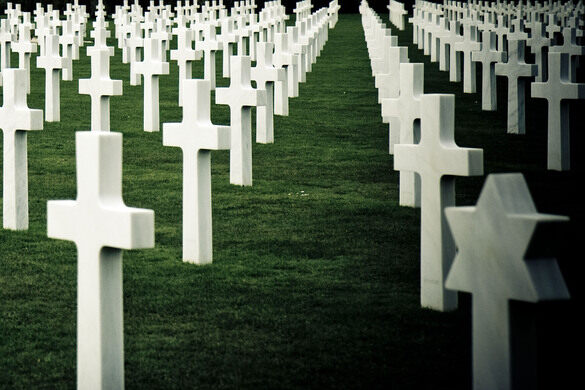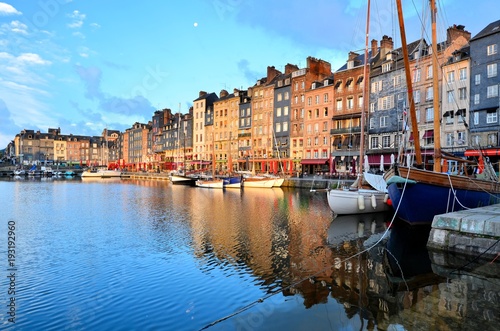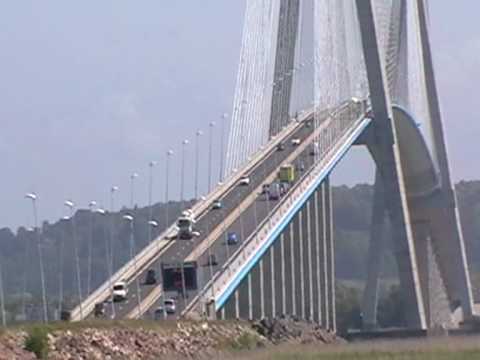Normandy has played an outsized role in European history. It first came to fame with the Norman invasion of England in 1066. Normans were the ultimate war machine and controlled most of southern Spain, Italy, and Sicily in the 1300s. The Arab-Norman churches in the Palermo era are the most beautiful in the world. D-Day in WWII was the first major offensive to wrest control of Western Europe from the Germans.
Camembert cheese comes from a town 60 km south of Honfleur. The distinctive round wooden boxes, in which Camembert is packaged to protect the soft disc during long-distance travel, date from 1890.
MONT ST-MICHEL (pop 44)
One of France’s most visited sites, this Unesco-listed abbey/fortress is also one of France’s most iconic images. Sitting on an island connected by a bridge, its spires, ramparts and rocky slopes rise dramatically from the sea. Despite all the tourists, its medieval streets still transport you back to the Middle Ages.
History. After a vision of the Archangel Michael, the bishop built a devotional chapel on the summit of the island in 708. In 966, it was given to the Benedictines who turned it into an ecclesiastical fortress with a military garrison. During the 15th century Hundred Years War, the English blockaded it three times, but it was the only place in western and northern France not to fall into English hands. After the revolution, it became a prison (see the treadmill powered by 6 hamster-like prisoners marching two abreast to raise stone and supplies to Mont), and in 1966, the abbey was returned to the Benedictines.
The masonry used to build the abbey was brought to the Mont by boat and pulled up the hillside using ropes.
In 2014 a 2km bridge was built to replace the causeway to return tides to flush away sediments and prevent the island from turning into a peninsula.
Parking. Try to avoid the time-based parking as it is so expensive. When I went in low season, go into the area to the west with restaurants and hotels where there was lots of free parking. You get penalized by walking and not taking the free shuttle (saving 30-40 minutes of walking) as you park for longer. I paid 11.7€ to park! Once into the one-way that leads to the gigantic parking area, it would be hard to reverse. One could also park at a restaurant on the east side and walk in. The free shuttle does not require a parking ticket to access.
I walked in for stunning views as you approached Mont St-Michel. Cross flat fields and then a long boardwalk. I took the shuttle back.

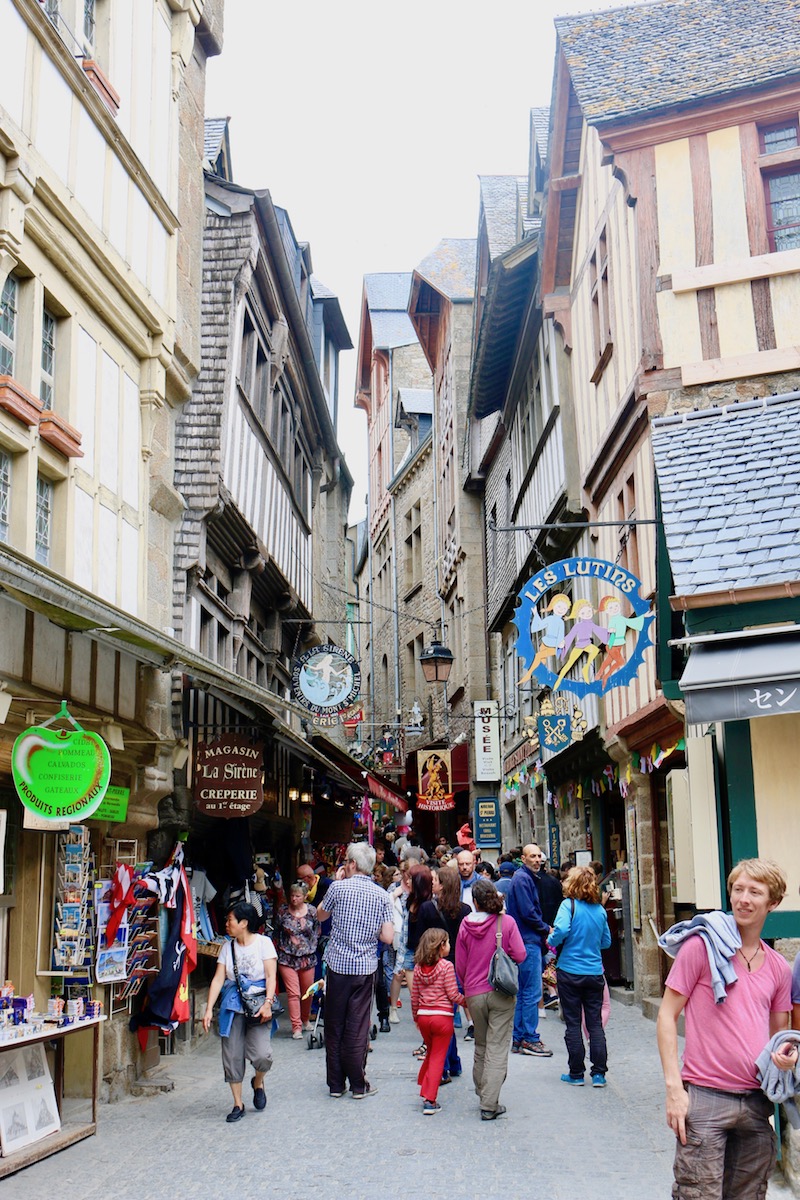
Sites. Enter the fortress and walk up the only real street, the Grande Rue, that climbs past expensive restaurants and souvenir shops. Opposite Restaurant La Croix Blanche, is a tiny 50cm wide passageway that accessed the diminutive parish church with its tiny cemetery. The road climbs and then ascends multiple steps. There are free tours in English at 11 and 3.
Abbays du Mont St-Michel. The star attraction, high up on top.
Abby Church. Built on the rocky tip, the transept rests on a solid rock while the nave, choir, and transept arms are supported by rooms below. The nave and south transept (11th and 12th centuries) are Norman Romanesque while the choir (late 15th century) is Gothic. A golden statue of the winged St Michael, the patron saint of the abbey, sits atop the bell tower.
La Merville (the Marvel). The buildings on the northern side were built by Philip Augustus in Gothic style after his troops burnt the monastery. Sites include the Cloister (one of the purest examples of 13th-century architecture to have survived with its double row of carved arches), dining room (early 13th century barrel-roofed with a wall of recessed windows; its steep wall precluded the use of flying buttresses), the gothic Guest Hall (from 1213 it has two enormous fireplaces), ambulatory (one of the oldest ribbed vaulted ceilings in Europe) and the Underground Chapel of Our Lady (one of the abbey’s oldest rooms rediscovered in 1903).
After touring La Merville, you exit to the ramparts that run the entire eastern side of Mont for spectacular views of the estuary. 10€ plus parking.
D-DAY BEACHES. Code-named ‘Operation Overlord”, the D-Day landings on the early morning of June 6, 1944, were the largest seaborne invasion in history. Three paratroop divisions landed behind enemy lines and 13,000 planes dropped bombs before the beach invasion. Swarms of landing craft, part of an armada of 6,000 ships and boats hit the 80 kilometres of beaches in northern Normandy and 45,000 Allied troops stormed ashore. The beaches north of Bayeux were code-named from west to east: Utah (US 4th and 8th infantry), Omaha (US 1st and 29th infantry), Gold (British 50th infantry), Juno (Canadian infantry), and Sword (British 3rd infantry). They were followed shortly by 90,000 more troops and the 70-day Battle of Normandy with 210,000 casualties and 37,000 killed started. German dead were estimated to be 200,000 with 200,000 prisoners taken. About 14,000 French civilians also died.
In order to unload the vast quantities of cargo needed for the invasion forces without having to capture intact one of the ports, the Allies set up prefabricated marinas (code-named Mulberry Harbours) off two of the landing beaches. 146 massive cement caissons were towed over from England and sunk to form two semicircular breakwaters from which bridge spans were moored. In the three months after D-Day, these facilitated the unloading of 2.5 million men, 4 million tons of equipment and 500,000 vehicles. 36 of them can still be seen off Arromanches-Les-Bains. The ones at Omaha were destroyed by a ferocious gale 2 weeks after D-Day.
Pointe du Hoc. These 30m high impossibly cliffs were ascended by 225 US rangers to disable the five 155mm German artillery guns perfectly placed to protect Utah and Omaha beaches. Over the 3 days, 81 were killed and 58 wounded. Good dioramas outline the scope of the attack, trails, bomb craters, the German command post, German bunkers, and good lookouts to explore.

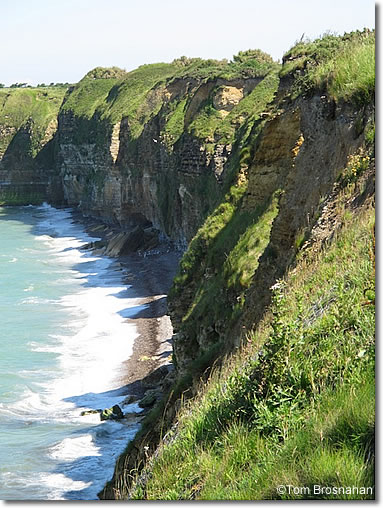
Normandy American Cemetery & Memorial. White marble crosses and Stars of David stretch off in seemingly endless rows on a bluff overlooking Omaha Beach. Featured in Steven Spielberg’s Saving Private Ryan, the cemetery contains the graves of 9387 (only 40% are in the cemetery, the other 60% were repatriated to the US; 1557 were not found) American soldiers including 45 pairs of brothers. Overlooking the gravestones is a large colonnaded memorial centred on a statue called the Spirit of the American Youth.
Omaha Beach. The most brutal fighting on D-Day took place on the 7km stretch of coastline, known as ‘Bloody Omaha’ to US veterans. Today Omaha is a peaceful place with sand sailors on the beautiful stretch of fine golden sand.
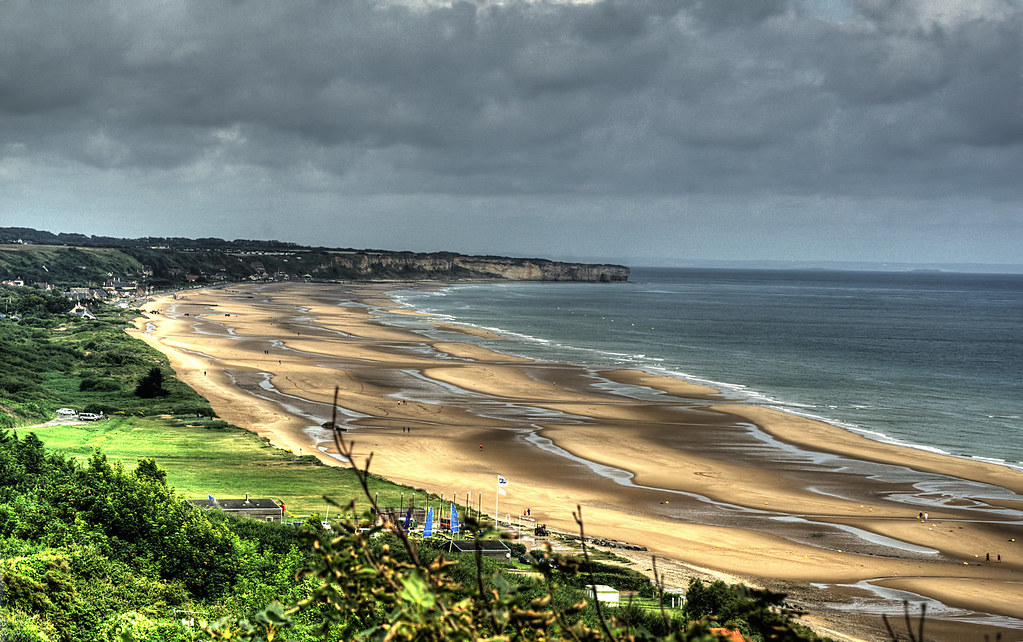
Juno Beach. Where the Canadian infantry landed, a museum details Canada’s role in the war effort. I didn’t go here.
BAYEUX TAPESTRY. The world’s most celebrated embroidery depicts the conquest of England by William the Conqueror in 1066 from a Norman perspective. Commissioned for the opening of the Bayeux cathedral in 1077, the 68.3m tells the dramatic bloody tale. I didn’t go here because I arrived after closing.
CAEN (pop 109,000). Founded by William the Conqueror in the 11th century, it is the capital of Haute Normandy. 80% was destroyed in the 1944 Battle of Normandy.
Chateau du Caen. Looming over the center of the city, this castle has great ramparts to explore.
I had booked an Air BnB here to have an address to mail a credit card to (it was hacked by online gamblers). I arrived after dark but the owner of the BnB spoke no English and he couldn’t find me in the maze of apartment buildings and parking lots! Crazy. I slept in my van and had already had the card mailed to England.
HONFLEUR. (pop 8200). This charming port town has a lovely old harbour evoking the maritime Normandy of the past. In the 16th and 17th centuries, Honfleur was one of France’s most important ports. Some of the earliest expeditions to Brazil and Newfoundland began here. In 1608, Samuel de Champlain set sail from Honfleur to found Quebec City.
It is a great town to walk around. See the old port and the 16th-century wooden church, Église Ste-Catherine.
PONT DE NORMANDIE. On the way from Honfleur, I crossed this futuristic soaring 2km arch of a bridge over the Seine. Two V-shaped columns hold aloft a net of cables. It must have the steepest inclines of any bridge in the world. And shortly after, cross an almost identical bridge just before turning west to go into Le Havre.
LE HAVRE (pop 176,000). A Unesco site since 2005, it is dedicated to modernism showing France’s postwar energy. All but obliterated in September 1944 by Allied bombing raids that killed 3000 civilians, the center was completely rebuilt by the Belgian architect Auguste Perret.
Église St-Joseph. Perret’s masterpiece, it’s 107m steeple is visible for miles from 1951-59. Using bare concrete and not looking particularly nice on the outside, the 13,000 panels of coloured glass make it striking at any time but especially when it’s sunny. Inside the circular church, fixed chairs surround the nave and massive concrete pillars soar to below the steeple.
Musée Malroux. Near the waterfront on the SE tip of town, this glass rectangular box houses the best collection of impressionist paintings outside of Paris – Monet, Boudin, and many others. Quite an enjoyable museum with simple captions.
Le Volcan. Le Havre’s most conspicuous landmark, the city’s premier cultural venue is a white volcano. Designed by the Brazilian Oscar Niemeyer.
ÉTRETAT (pop 1900). NW of Le Havre, this small village is fronted by a roaring beach (the crashing surf is followed by the noise of the large cobbles tumbling back down the steep beach. On each side are soaring limestone cliffs. To the left is a massive free-standing arch, likened to an elephant dipping its trunk in the sea and a 70m high spire of rock. Take a steep footpath that starts right at the end of the beach to climb to the top of the plateau above the arch. To the right is another high limestone cliff, with a small arch and on top, a memorial where two aviators were last seen on an attempt to cross the Atlantic n 1927.
German pillboxes and a series of dioramas explaining the history of the town are also on the left beachfront.
ROUEN (pop111,000). It was devastated by fire and plague several times in the Middle Ages, and occupied by the English in the Hundred Years War, Joan of Arc is from here and was burned at the stake in the central square in 1431, and in WWII, allied bombing destroyed most of the city south of the cathedral.
Cathedrale Notre Dame. This Gothic cathedral was built between the 12th and 16th centuries and declared a Unesco site (along with the two other half-timbered churches of St Ouen and St Macron). The 75m-tall Butter Tower was financed by locals in return for being able to eat butter during Lent. Like most Gothic churches, its façade is over the top with carved figures and spiked tours. I found it dark and gloomy inside the massive interior.

Historial Jeanne d’Arc. Follow what earned her fame and shortly thereafter, her condemnation in this theatre-like experience where you see and hear the dramatic retelling of her life and death. 10€
Musée Le Secq des Tournelles. Home to one of the world’s premier collections of wrought iron, it showcases the extraordinary skills of pre-industrial iron- and locksmiths. It is housed in a desanctified 16th-century church. Free
Musée des Beaux-Arts. Housed in a grand mansion, this fine art museum supposedly had Ruebens, Pissarro, Renoir, Sisley, and several Monets. I couldn’t find any of these but saw a ton of paintings and some bad photography. Free
JEANNE d’Arc (1412-1431)
Political context. Between 1407 and 1429. France was involved in a Civil War between the dukes of Orleans and Burgundy. King Henry V of England took advantage of the situation and broke a truce restarting the second phase of the Hundred Years War by invading Normandy in 1415. The English controlled the southwest and most of the north of France at the time.
Biography. Jeanne was very pious as a youth and when 13, heard a revelation to liberate France. In 1429, the ‘voices’ became more frequent. She was endowed with great charisma and acquired notoriety as a healer.
Wearing masculine clothes and having a man’s hairstyle, she had an audience with Dauphin Charles and announced four events: the liberation of Orleans, the coronation of the king at Reims, the liberation of Paris, and the liberation of the Duke of Orleans. Charles sent her to Orleans where she infused the French army with new energy forcing the English to lift the siege of the city in May 1429. She persuaded Charles to go to Reims to be crowned King of France in July, interpreted by many to be the result of her divine will. These miracles greatly contributed to her legend.
Jeanne led an attack on Paris in September and was injured by a crossbow bolt and the attack was called off. Charles prohibited any new assault, but Joan considered herself independent and led a campaign showing courage winning several cities. She was captured by the Burgundians in May 1430, and she tried unsuccessfully to escape twice.
She was charged with heresy and falsely imagining revelations and divine apparitions with her trial beginning in February 1431. She was found guilty of being schismatic, apostate, lying, diviner, suspicious of heresy, wandering in faith, a blasphemer of God and saints. The court condemned her to die at the stake.
Cardinal Winchester insisted that nothing be left of her body to avoid any posthumous cult of the “maid” and ordered three successive cremations. The second lasted several hours and blew the skull and the abdominal cavity of which pieces were projected onto the public below, leaving in the center of the pyre the calcined organs except the bowels and the heart (more humid organs burning less quickly) remained intact. For the third, the executioner added oil and pitch, and then the only remains were ashes and bone debris that were scattered in the Seine.
Pope Callistus III authorized the trial of nullity of her condemnation in 1455 and ordered a study in the depth of the proceedings of the trial. This led to breaking the first judgment for “corruption, fraud, slander, fraud, and malice”. The judgment, pronounced in July 1456 said the first trial and its findings were “null, void, without force or effect” and fully rehabilitated Jeanne and her family. It also ordered the “application of a decent cross for the perpetual memory of the dead” in the same place where Joan died. Most of the judges in the first trial, including Bishop Cauchon, had died in the meantime.
Jules Quicherat wrote an almost exhaustive five-volume historiography of Joan between 1841 and 1849 and many writers, politicians, and religious have appropriated Joan of Arc with numerous writings. None were contemporary and often reinterpreted the original sources.
The two trials had obvious political influence, and the inquisitorial method supposed that the accused and the witnesses answer only the questions asked. Moreover, the trial of 1431 was transcribed in Latin while the interrogations were in French.
From the beginning legends ran about her, concerning her childhood, her prophecies, her mission, the miracles or wonders and she developed mythological status. Joan of Arc was very popular during her lifetime and the ride to Reims made her known abroad. The exceptional nature of her epic fed countless rumours in France.
Doctors of theology of the Catholic Church considered her a threat to their authority,
Jeanne undeniably reversed the psychological mood in favour of France, by raising the morale of the army and population, legitimizing and sacrificing the king, and by showing that the reputation of invincibility of the English was false. At the head of the warriors, she kept amid the armies a purity. Events worthy of memory, though, there is more admiration than any credence.
Since the 19th century, the exploits of Joan of Arc have been usurped to serve certain political purposes – the exploitation of a heroine who symbolizes France mythically, even mystically, is innumerable. It has been suggested that she was a political instrument intended to throw terror into the English troops, and the so-romantic hand of God
Institutional recognition. Joan of Arc is the seventh most celebrated figure on the pediment of the 67,000 French schools as of 2015 – no less than 423 schools, colleges and high schools (including 397 in the private sector) gave it its name, behind Joseph (880), Jules Ferry (642), Jacques Prévert (472), Jean Moulin (434), Jean Jaures (429), but before Antoine de Saint-Exupery (418), Victor Hugo (365), Louis Pasteur (361), Marie Curie (360), Pierre Curie (357), Jean de la Fontaine (335).
Recognition by the Catholic Church – Canonization. She was beatified on April 18, 1909, and canonized on May 16, 1920. Her religious holiday is set for May 30, the anniversary of her martyrdom. Pius XI proclaimed her patron saint side of France in 1922.

